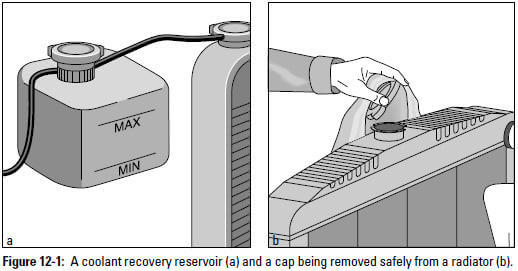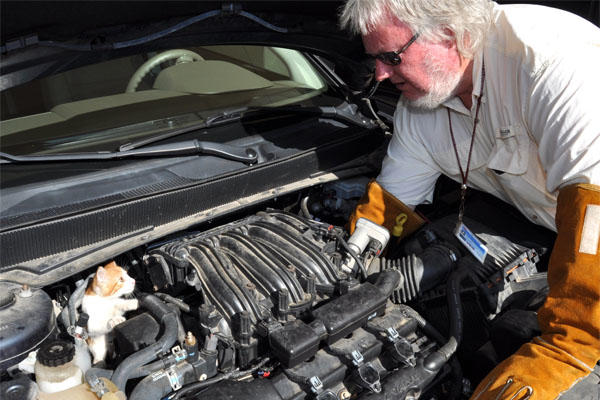Checking and Adding Liquid to Your Cooling System
One of the quickest, easiest, and least expensive tasks you can perform to keep your cooling system cool is to check the fluid level in the system and, if necessary, add water and coolant. Before you attempt to do anything to your cooling system, be aware of two important safety rules:
NEVER REMOVE THE PRESSURE CAP WHEN THE ENGINE IS HOT.NEVER ADD COLD WATER TO A HOT ENGINE!
Removing a Pressure Cap Safely
Caution: Before you can do anything involving your cooling system, you need to know how to remove the pressure cap safely. It's dangerous to remove the pressure cap from the radiator or coolant recovery system reservoir while the engine is still warm. Because it's hard to tell just how hot things are inside the engine, follow these guidelines when removing a pressure cap:
- Keep your cool until your car regains its own! Never remove the cap from a radiator or coolant recovery system reservoir when the engine is hot. Because adding cold water to a hot engine can crack the engine block, you have no reason to remove the cap until the engine temperature drops to a safe level.
- If your engine overheats on the highway, get safely to the side of the road, turn off the ignition, and then wait 15 to 20 minutes for things to cool down. If you can stay safely away from traffic, you can lift the hood to help the heat escape but you should leave the pressure cap alone.
- If you're parked where traffic is zooming by, or if you're concerned about your security if you leave your vehicle, you're better off just waiting in the car until the engine cools. If it heats up again when you start driving, get to the nearest service station or a place where you can safely park, get out, and deal with the situation yourself.
To remove the pressure cap safely, follow these steps after the engine is cool:
- Don't remove the cap on the radiator unless your vehicle has no plastic coolant recovery reservoir. (These days, almost every vehicle does; Figure 12-1 shows you what one looks like.)
- If your system has a safety pressure cap, lift the lever on the safety cap to allow the pressure to escape.
Tip: To keep from burning your hand, place a cloth over the cap after you raise the lever (see Figure 12-1). Then turn the cap counterclockwise toremove it.

|
If your vehicle doesn't have a safety cap, place a cloth over the capand turn it counterclockwise just to its first stop.
Caution: Turning to the first stop allows some of the pressure to escape, but if you see liquid or a great deal of steam escaping, retighten the cap and wait for things to cool down. If nothing escapes, continue turning the cap counterclockwise to remove it.
- Tilt the cap as you remove it so that the opening points away from you (and anyone else nearby). If there's still enough heat and pressure to spray hot stuff around, it lands on the engine or inside the hood, where it can do no harm. Be particularly sure to follow this procedure if you don't have a safety cap.
- When you finish, replace the cap by screwing it on clockwise. (If youhave a safety pressure cap, push the lever down again.)
Tip: Radiator safety caps cost very little, so if you don't have one, buy one! Almost every service station stocks them, but they're cheaper in auto supply stores. Check your owner's manual for the amount of psi (pounds per square inch) of pressure in your system and look for the proper number of psi on thenew cap. These safety caps are well worth the money.
Car Smarts: Of course, if the engine is completely cold, you face no risk at all, so get into the habit of checking your coolant level at least once a month in the morning before you warm up the engine, as part of an under-the-hood check.
From Auto Repair for Dummies, copyright © 2009 by Wiley Publishing, Inc., Indianapolis, Indiana. Used by arrangement with John Wiley & Sons, Inc.










